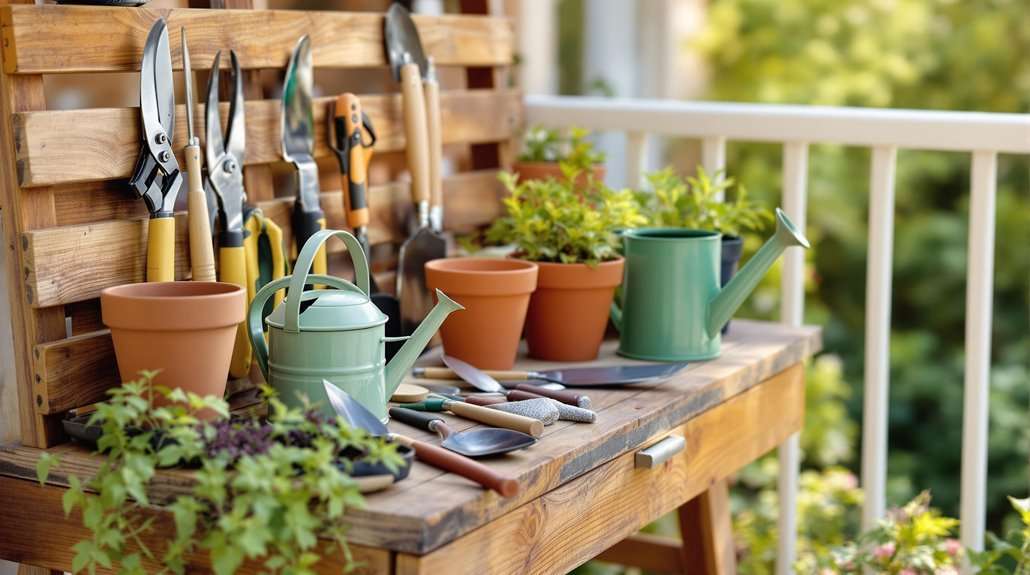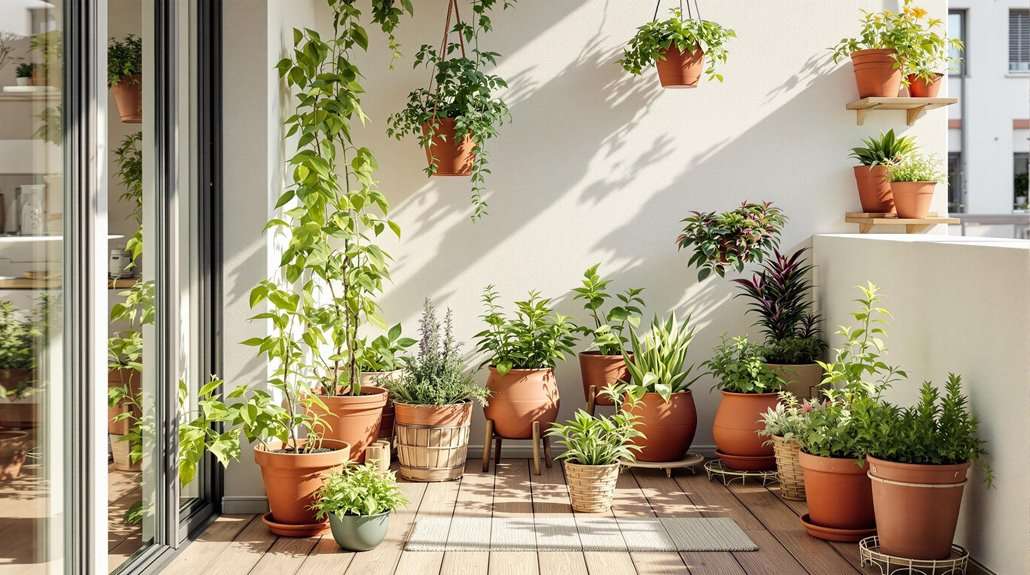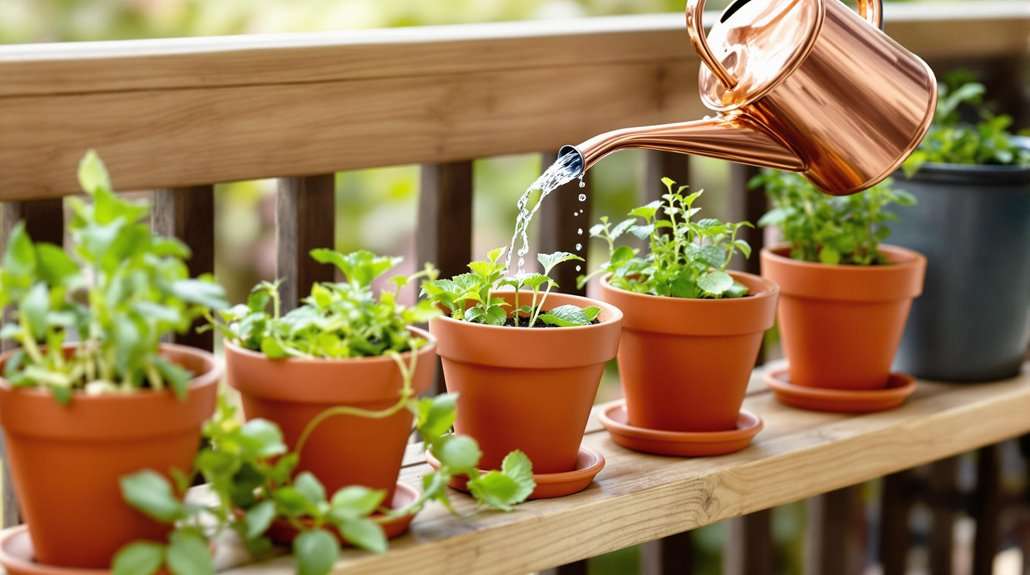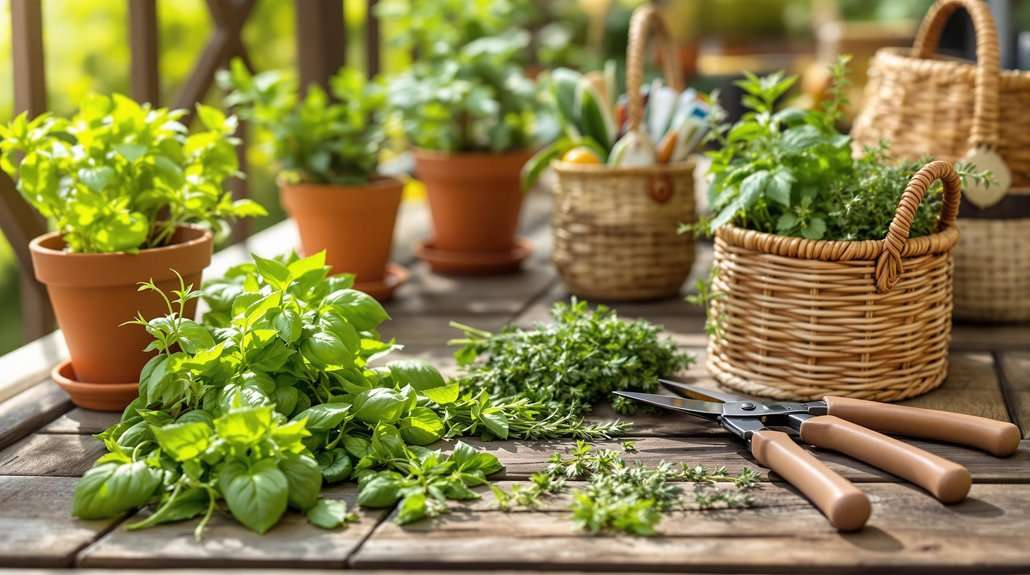How to Grow Herbs on a Balcony
You can grow a flourishing herb garden on your balcony by starting with essential tools like a sturdy trowel, watering can, and well-draining containers at least 8-12 inches deep. Choose herbs based on your sunlight conditions, as most need 4-6 hours of direct sun daily, and group them according to similar water needs. Use high-quality potting mix and guarantee proper drainage by adding broken pot pieces at the bottom. Water thoroughly, especially during summer, and protect sensitive herbs in winter with horticultural fleece. Start with compact varieties like dwarf basil, and maintain regular harvesting to promote bushy growth. Exploring advanced techniques will help you create an even more productive garden space.
This post may contain affiliate links. If you make a purchase through these links, I may earn a commission at no additional cost to you. Additionally, portions of this post may be generated using artificial intelligence (AI) technology. While we strive for accuracy, please be aware that AI-generated content may not always be perfect and should be fact-checked when necessary.
The Spatula Scoops
- Choose containers 8-12 inches deep with proper drainage holes and group herbs with similar water needs together.
- Most herbs need 4-6 hours of direct sunlight daily, so position containers accordingly on your balcony.
- Use high-quality, well-draining potting mix and avoid garden soil, which can become compacted in containers.
- Keep invasive herbs like mint in separate containers and consider compact varieties for small balcony spaces.
- Water thoroughly when soil feels dry, harvest regularly with clean scissors, and protect plants from extreme weather conditions.
Essential Tools and Equipment

A well-equipped balcony herb garden starts with the right tools. You'll need a sturdy trowel for transplanting and weeding, along with a hand cultivator to mix soil and spread mulch effectively. Selecting quality garden tools ensures your gardening tasks are more efficient and enjoyable. Don't forget pruners or snips, which you'll use frequently for harvesting and maintaining your herbs.
For watering needs, you'll want to invest in a watering can with a long spout for precise control. If you're planning a larger setup, consider an automatic irrigation system to guarantee consistent moisture levels. A 1-gallon spray tank comes in handy for applying fertilizers and managing pests when needed.
Organization is essential in a limited space, so you'll want to include a tool storage container to keep everything accessible. Adding proper shelving and pot racks helps maximize your vertical growing space, while garden markers guarantee you can identify different herbs easily. For routine maintenance, keep a small broom nearby for cleanup, and have scissors ready for regular harvesting. Consider adding grow bags to your collection – they're perfect for starting new herbs and can be easily moved around your balcony as needed.
Selecting Your Herbs
With your tools ready, it's time to choose the right herbs for your balcony garden. Consider your space's sunlight conditions, as most herbs need at least 6 hours of direct sun daily. Mediterranean herbs like rosemary, basil, and oregano thrive in full sun, while herbs such as parsley and cilantro can manage with partial shade. Grouping herbs with similar care requirements together helps create efficient space usage through thoughtful arrangement.
Think about whether you'd prefer annual or perennial herbs. Annual herbs like basil need replanting each season, while perennials such as thyme and oregano return year after year. You'll also want to factor in maintenance requirements and space constraints, as some herbs like mint can spread aggressively and may need containment.
- Choose compact varieties that won't overwhelm your balcony space, such as dwarf basil or container-friendly thyme
- Select herbs you'll actually use in your cooking to guarantee regular harvesting and maintenance
- Mix sun-loving Mediterranean herbs in areas with direct sunlight, and shade-tolerant herbs like parsley in less sunny spots
- Consider grouping herbs with similar water needs together – drought-resistant sage and rosemary make excellent companions
Remember to provide proper drainage for your chosen herbs and position containers where you can easily access them for regular harvesting and care.
Creating the Perfect Growing Environment

Once your herbs are selected, creating an ideal growing environment becomes vital for their success. Most herbs need 4-6 hours of direct sunlight daily, with Mediterranean varieties like basil and rosemary thriving in full sun. If you've got a south-facing balcony, you're already ahead of the game, but don't worry if you don't – herbs like mint, chives, and parsley can manage with less light.
Your soil setup is essential for healthy herbs. Use a high-quality potting mix that drains well, and don't be tempted to use garden soil from outside. Mix in sand or perlite for herbs that prefer drier conditions, like rosemary, while keeping the soil less gritty for moisture-loving plants like mint. Choose containers that match your herbs' needs – breathable grow bags work well for plants that like drier conditions. Lightweight containers made from polypropylene resin are perfect for balcony gardening. Consider using Food Container Sets to store and organize your herbs and other ingredients.
For peak growth, rotate your containers a quarter turn daily to guarantee even light distribution. You can also use rail planters or movable pots to adjust your herbs' sun exposure throughout the day. During winter, create a microclimate by positioning containers against exterior walls or near windows for protection.
Planting Your Balcony Garden
Planning your herb layout marks the start of bringing your balcony garden to life. Begin by selecting containers that'll provide adequate drainage and space for your chosen herbs, making certain they're appropriate for your balcony's size. As you prepare to plant, fill your containers with high-quality potting mix, adding sand or perlite to improve drainage if needed. Spring planting offers optimal growing conditions for most herbs.
Before you start planting, consider grouping your herbs based on their water and sunlight needs. You'll want to space them properly to prevent competition and ascertain good air circulation. When you're ready to plant, carefully remove each herb from its nursery pot, gently loosen the roots, and place it in a pre-made hole at the appropriate depth.
- Select south-facing spots for herbs that need full sun, guaranteeing at least 4 hours of direct sunlight
- Group herbs with similar care requirements together, such as drought-tolerant Mediterranean varieties
- Space plants according to their mature size, leaving room for growth and air circulation
- Plant invasive herbs like mint in separate containers to prevent them from overwhelming others
After planting, water thoroughly to help the soil settle around the roots and eliminate air pockets.
Watering and Feeding Guidelines

When it comes to feeding, you don't need to fertilize herbs frequently – once or twice annually is sufficient. Choose a balanced liquid fertilizer (10-10-10 or 5-10-5) diluted with water, and apply it during the growing season. For best results, plant your herbs in a well-draining, gritty substrate that combines peat-free and loam-based compost. Additionally, consider exploring our free recipe ebook for inspiration on using your fresh herbs in a variety of dishes.
To maximize success, group herbs with similar water requirements together. Mediterranean herbs like rosemary and thyme prefer drier conditions, while soft-stemmed herbs need more consistent moisture. You'll also want to take into account your balcony's orientation – south-facing spots are ideal. Monitor soil moisture regularly by checking the top inch of soil, and don't forget to add drainage materials like broken pot pieces to prevent waterlogging.
Seasonal Care and Protection
To keep your balcony herb garden thriving year-round, you'll need different protection strategies for each season, from using glass cloches in spring to moving sensitive plants indoors during winter. During summer's intense heat, you can protect your herbs by relocating containers to shadier spots and adjusting your watering schedule to prevent moisture loss. Container plants require extra attention to moisture levels as they can dry out quickly in hot conditions. As temperatures drop in fall and winter, you'll want to focus on protecting cold-sensitive herbs by either bringing them indoors or using protective covers, while hardy varieties like thyme and rosemary can typically withstand cooler conditions with minimal protection.
Winter Protection Methods
With winter's harsh conditions approaching, protecting your balcony herbs becomes essential for their survival. You'll need to assess each plant's hardiness zone and prepare accordingly, especially since balcony herbs in containers are more vulnerable to temperature fluctuations than ground-planted varieties. For successful overwintering, you'll want to select containers that are 8-12 inches deep and maintain proper drainage to prevent waterlogging. Water your herbs in the early morning hours to prevent moisture from freezing on leaves overnight.
To maximize your herbs' winter survival rates, implement these critical protection methods:
- Wrap sensitive herbs like bay trees and rosemary in horticultural fleece or bubble wrap, creating a protective barrier against frost
- Elevate terracotta containers off the balcony floor using pot feet or blocks to prevent cracking and water damage
- Position containers against the building wall where they'll benefit from residual heat and wind protection
- Layer mulch or straw around the base of perennial herbs for additional insulation
Monitor your herbs regularly during winter months, checking soil moisture levels by lifting pots to assess their weight. If you're growing tender herbs like basil, you'll need to bring them indoors to a well-lit, frost-free location, as they won't survive outdoor winter conditions on your balcony.
Summer Heat Management
During scorching summer months, managing heat stress becomes vital for your balcony herbs' survival. You'll need to adjust your watering schedule by checking the top inch of soil daily and increasing frequency when it feels dry. It's best to water early in the morning using a drip irrigation system to guarantee efficient moisture distribution while minimizing evaporation. For optimal growing conditions, consider placing Mediterranean herb varieties together in designated containers.
Protection from intense sunlight is essential for your herbs' well-being. Install a sheer curtain or shade cloth to filter harsh rays, and consider repositioning your containers to partially shaded areas during peak sun hours. You can also use reflective surfaces strategically to redirect excessive sunlight away from sensitive plants.
Pay careful attention to your soil composition and maintenance practices. Use a lightweight, well-draining potting mix and apply a layer of mulch to help regulate soil temperature and retain moisture. While fertilizing is important, avoid over-feeding during hot weather, as this can stress your plants. Instead, opt for balanced fertilizer applications and regular monitoring for signs of pest infestation or disease. Remove any affected plants promptly to prevent issues from spreading to healthy herbs.
Spring Growth Strategies
As winter gives way to spring, your balcony herb garden needs specific preparation for ideal growth. Start by selecting frost-resistant containers with proper drainage and fill them with high-quality potting mix enhanced with perlite. You'll want to position your containers in spots that receive maximum sunlight, particularly for Mediterranean herbs like rosemary and sage. Observing daily sun exposure patterns will help determine the optimal placement for your containers.
Early spring is the perfect time to divide overgrown perennials and prune woody herbs back to 3-4 inches, encouraging robust new growth. Begin fertilizing sparingly with diluted liquid fertilizers, and monitor soil moisture carefully as spring rains can sometimes lead to waterlogging. For tender herbs, use glass cloches to protect against unexpected frost while allowing seedlings to develop strong root systems.
- Start basil seeds indoors 4-6 weeks before the last frost date
- Layer herbs like rosemary and thyme for natural propagation
- Combine herbs with similar growing requirements for better pest management
- Mulch containers to protect roots and maintain consistent soil moisture
Remember to gradually acclimate indoor-started plants to outdoor conditions through a process called hardening off, ensuring their successful adjustment to your balcony environment.
Harvesting Methods

Proper harvesting techniques guarantee your balcony herbs stay healthy and productive throughout the growing season. You'll want to use clean, sharp scissors or pruning shears, and always harvest in the early morning after the dew has dried but before the day heats up, when the herbs' essential oils are most concentrated. Regular trimming helps prevent woody growth and maintains plant vigor.
For annual herbs like basil and cilantro, you can cut stems back to just above a leaf node, taking up to one-third of the plant at a time. With perennial herbs such as thyme and rosemary, be more conservative and trim only the leafy tips to maintain the plant's vigor. When harvesting mint, cut the stems before flowering begins, and for chives, cut them about two inches above the soil level.
To store your freshly harvested herbs, rinse them thoroughly and pat them dry. You've got several storage options: stand them in a glass of water like flowers and cover with a plastic bag in your refrigerator, or wrap woody-stemmed herbs in damp paper towels. Don't forget to change the water every few days to keep your herbs fresh and ready to use.
Expanding Your Balcony Garden
Once you've mastered growing basic herbs, you can expand your balcony garden by introducing companion plants like marigolds and nasturtiums, which naturally deter pests while adding vibrant colors to your herb collection. Your vertical space offers endless possibilities through wall-mounted planters, tiered stands, and hanging baskets, allowing you to grow more varieties without sacrificing precious floor space. Beyond the common herbs like basil and oregano, you'll find satisfaction in growing unique varieties such as lemon verbena, Vietnamese coriander, or purple sage, which add exciting flavors and visual interest to your garden. Additionally, don't forget to explore the importance of baking tools in the kitchen, which can elevate your culinary creations to the next level.
Companion Plants For Herbs
Growing herbs alongside compatible plants can transform your balcony garden from a simple collection into a thriving ecosystem. When selecting companion plants, you'll want to take into account which herbs share similar growing requirements and can benefit each other. For example, drought-tolerant herbs like sage and rosemary make excellent companions, while shade-tolerant herbs such as mint and chives can thrive together in partially shaded areas. Traditional companion planting techniques have helped gardeners improve growth and control pests for centuries.
Keep in mind the mature size and growth habits of your plants when planning your combinations. You'll need to provide adequate spacing, typically one non-aggressive herb per 6 inches of pot space. Remember to group plants with similar water needs together, as this will make maintenance much easier and guarantee all plants receive appropriate care.
- Plant pollinator-friendly flowers like native wildflowers to attract beneficial insects
- Combine herbs with different flowering times to maintain year-round interest
- Mix annual and perennial herbs for varied growth patterns and harvesting seasons
- Group herbs with similar water requirements to simplify maintenance
When planning your companion plantings, avoid overcrowding by using appropriately sized containers. A 12-inch pot can comfortably house 3-5 annual herbs, while perennial herbs may need more space to establish their root systems properly.
Space-Saving Vertical Solutions
Beyond pairing compatible herbs together, maximizing your balcony's vertical space can double or triple your growing area. You'll find numerous options to grow upward, from wall-mounted planters and hanging baskets to converted wooden pallets and tiered systems that make the most of limited floor space. The ideal setup requires south-facing placement for optimal herb growth.
Start by evaluating your balcony's structure for mounting options. You can attach sturdy hooks to the ceiling for hanging baskets, or install chicken wire along railings to support climbing herbs. For a more structured approach, consider installing tiered planters or converting a wooden pallet into a vertical herb garden. When selecting containers, opt for lightweight materials like plastic, fiberglass, or fabric grow bags that won't overburden your balcony's weight limits.
Remember to group your herbs strategically in these vertical arrangements. Place taller specimens like lemon verbena at the back or top of your vertical setup, while keeping compact, shade-tolerant herbs like mint and chives in lower positions. For year-round interest, incorporate evergreen herbs such as rosemary and sage into your vertical design, ensuring each plant has adequate space and drainage.
Growing Beyond Basic Herbs
After mastering basic herbs like basil and mint, four exciting categories of advanced herbs can transform your balcony garden into a sophisticated culinary paradise. You'll want to explore unique varieties like Vietnamese coriander and lemon verbena, which offer distinctive flavors while adapting well to container growing. When planning your advanced herb collection, group plants with similar needs together, particularly those sharing water and light requirements.
Consider these key aspects for success with advanced herbs:
- Plant deep-rooted herbs like coriander in containers at least 12 inches deep
- Group Mediterranean herbs together, such as rosemary, thyme, and oregano
- Incorporate ornamental varieties like golden mustard or pomegranate flowers
- Rotate seasonal herbs throughout the year for continuous harvests
Your advanced herb garden requires careful attention to specific growing conditions. Gradually acclimate new plants to outdoor conditions, and maintain a well-draining potting medium for peak growth. Remember to pinch back herbs regularly to encourage bushy growth and prevent flowering, unless you're specifically growing them for their blooms. With proper planning and care, you'll create a diverse and productive herb garden that elevates your cooking to new heights.
Frequently Asked Questions
Can I Grow Herbs in Recycled Containers Like Milk Jugs?
You can transform those empty milk jugs into thriving herb gardens with just a bit of preparation. You'll need to thoroughly clean the containers, punch drainage holes in the bottom, and fill them with quality potting mix. While milk jugs work well for smaller herbs like basil and parsley, you'll want to guarantee they're UV-resistant to prevent degradation. Remember to sterilize the containers first to prevent any bacterial growth.
How Do I Prevent Cats From Disturbing My Balcony Herb Garden?
You can protect your balcony herbs from cats by installing physical barriers like chicken wire or mesh around your containers. Place double-sided tape on railings to discourage climbing, and use natural deterrents like citrus sprays around your plants. Consider offering your cats alternative spaces with climbing structures and their own cat-friendly plants. Secure your herb containers with heavy pots, and cover the soil with small rocks or marbles.
Will My Herbs Affect Neighboring Balconies Through Cross-Pollination?
Your herbs can affect neighboring balconies through cross-pollination, particularly if you're growing mint, lemon balm, dill, or fennel. Wind and pollinators can carry pollen significant distances. To minimize this impact, you'll want to place herbs away from balcony edges, use physical barriers like mesh screens, and regularly deadhead flowers. For extra precaution, you can group similar herbs together or use container planting.
Can Strong Cooking Smells From Neighbors Harm My Herb Plants?
While you might imagine your neighbor's spicy curry fumes wreaking havoc on your delicate herbs, you don't need to worry. Cooking smells alone won't harm your plants. However, you'll want to watch out for greasy particles and air pollutants that can coat leaves and interfere with photosynthesis. Keep your plants well-ventilated, clean their leaves regularly, and consider using barriers if you notice any buildup of cooking residue.
Should I Remove Dead Insects That Collect in My Herb Containers?
Yes, you should remove dead insects from your herb containers regularly. They can decay and spread diseases to your plants, while also attracting more pests. Use a small tool to gently scoop them out, or brush them away with a soft brush to avoid disturbing the soil. It's best to check your containers daily during peak insect seasons and remove any dead insects as soon as you spot them.





